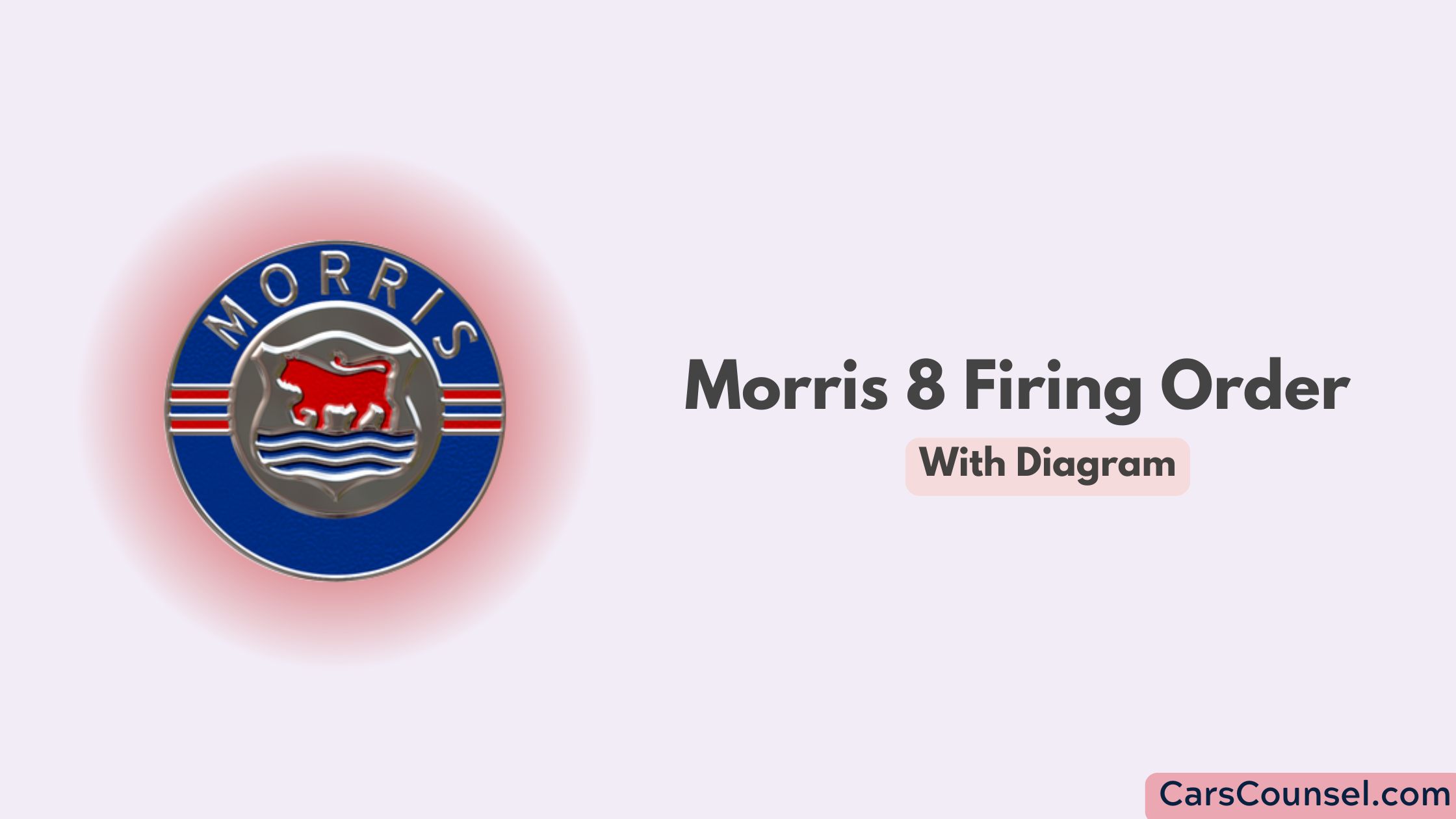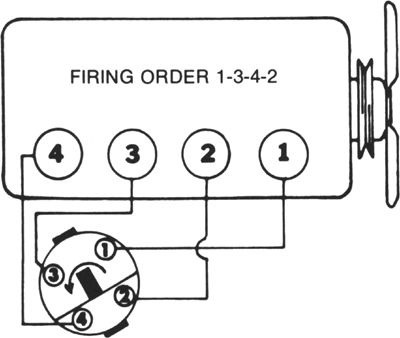The Morris 8, produced by Morris Motors between 1935 and 1948, is a beloved classic car that played a key role in making motoring more accessible in Britain. This small, affordable car had a reliable four-cylinder engine that provided modest performance and excellent durability.
Central to the engine’s functionality is its firing order, which ensures smooth and efficient operation.
In this article, we’ll explore the firing order of the Morris 8 engine, its importance, and how it contributes to the car’s performance. Whether you’re restoring a Morris 8, maintaining one, or simply curious about its engineering, this guide will provide you with all the essential details.

Quick Navigation
The Morris 8 Firing Order
The firing order for the Morris 8 engine is: 1-3-4-2

How the Firing Order Works
- Cylinder 1 Fires First: Located at the front of the engine (closest to the radiator), it initiates the combustion cycle.
- Cylinder 3 Fires Next: Ignition moves to the third cylinder, skipping the second.
- Cylinder 4 Fires Third: The rearmost cylinder ignites next.
- Cylinder 2 Fires Last: The second cylinder completes the sequence, returning the cycle to Cylinder 1.
This alternating sequence ensures smooth operation by balancing the firing events across the engine.
Why the 1-3-4-2 Firing Order Works for the Morris 8
The 1-3-4-2 firing order is specifically designed for the Morris 8’s inline-four engine to achieve several advantages:
- Balance: Alternating between cylinders in different positions minimizes vibrations and keeps the engine running smoothly.
- Efficiency: Proper timing allows the air-fuel mixture to burn completely, maximizing power and fuel economy.
- Simplicity: The firing order works seamlessly with the engine’s simple crankshaft and camshaft design.
- Durability: The sequence reduces stress on the engine’s moving parts, extending its lifespan.
What Is a Firing Order?
The firing order refers to the sequence in which the engine’s cylinders fire, or ignite, the air-fuel mixture. This combustion powers the pistons, which rotate the crankshaft and drive the vehicle. The firing order is carefully designed to optimize engine performance, reduce vibrations, and maintain balance.
Why the Firing Order Is Important
- Smooth Operation: A correct firing sequence minimizes vibrations, allowing the engine to run evenly.
- Performance: Ensures consistent power delivery for smooth acceleration.
- Efficiency: Promotes complete combustion of the air-fuel mixture, improving fuel economy.
- Durability: Reduces wear and tear on the crankshaft and internal components by distributing mechanical stress evenly.
Overview of the Morris 8 Engine
The Morris 8 is powered by a 918cc, inline-four-cylinder engine. This small yet sturdy engine offered adequate performance for its time, making the car suitable for urban and rural use. The simplicity of its design is one reason for its enduring appeal among classic car enthusiasts.
Key Features of the Morris 8 Engine
- Inline-Four Layout: Four cylinders are arranged in a straight line, which is typical for compact cars of its era.
- Side-Valve Design: The engine uses a side-valve layout, which was common in pre-war cars for its simplicity.
- Cylinder Numbering:
- Cylinder 1: Closest to the radiator.
- Cylinder 4: Closest to the dashboard.
Identifying the Firing Order
Understanding and verifying the firing order is essential for maintaining and troubleshooting the Morris 8 engine. Here’s how you can confirm it:
Check the Owner’s Manual
The owner’s manual provides detailed engine specifications, including the firing order and cylinder numbering.
Inspect Cylinder Numbers
Cylinder numbers are often stamped on the engine block or marked near the spark plugs for easy identification.
Use Timing Tools
The distributor cap and ignition timing tools can help confirm the firing sequence during maintenance or repairs.
Symptoms of Incorrect Firing Order
An incorrect firing order can cause noticeable issues that affect the engine’s performance and reliability. Recognizing these symptoms can help you diagnose and fix problems promptly.
Common Symptoms
- Engine Misfires: Cylinders fail to ignite properly, leading to uneven power delivery.
- Rough Idling: The engine vibrates excessively or feels unstable when idling.
- Loss of Power: The car struggles to accelerate or maintain speed due to disrupted combustion.
- Unusual Noises: Knocking, pinging, or backfiring sounds may occur if the firing order is incorrect.
- Increased Fuel Consumption: Inefficient combustion leads to higher fuel use and emissions.
Causes of Incorrect Firing Order
- Misconnected Spark Plug Wires: Spark plug wires routed to the wrong cylinders disrupt the ignition sequence.
- Faulty Distributor Timing: A misaligned distributor can cause improper ignition timing.
- Worn Components: Damaged spark plugs, ignition wires, or distributor caps may interfere with the firing sequence.
Diagnosing and Fixing Firing Order Problems
If you suspect an issue with the firing order in your Morris 8 engine, follow these steps to diagnose and resolve it:
Diagnostic Steps
- Inspect Spark Plug Wires: Ensure each spark plug wire is connected to the correct cylinder in the 1-3-4-2 sequence.
- Check Distributor Cap: Verify that the distributor cap is properly aligned and functioning correctly.
- Use a Timing Light: Confirm ignition timing with a timing light and compare it to the manufacturer’s specifications.
- Perform a Compression Test: Ensure that all cylinders have adequate compression for proper combustion.
Fixing Common Issues
- Reconnect Spark Plug Wires: Route the wires correctly to their corresponding cylinders based on the firing order.
- Adjust Distributor Timing: Align the distributor to ensure proper ignition synchronization.
- Replace Faulty Components: Install new spark plugs, ignition wires, or distributor caps if they are damaged or worn.
Preventative Maintenance for Firing Order Reliability
Maintaining the correct firing order is essential for ensuring the Morris 8 engine runs smoothly. Follow these preventative measures to avoid issues:
Regular Inspections
- Check the condition of spark plugs, ignition wires, and distributor caps during routine maintenance.
- Look for loose connections, corrosion, or visible damage.
Replace Components as Needed
- Replace spark plugs and ignition wires at intervals recommended for classic cars.
- Use high-quality components that match the specifications of the Morris 8 engine.
Verify Timing
- Periodically check the ignition timing to maintain accurate synchronization.
- Perform timing adjustments during scheduled maintenance or after significant repairs.
FAQs About the Morris 8 Firing Order
Can I Change the Firing Order?
No, the firing order is fixed by the engine’s design and crankshaft configuration. Altering it would require significant modifications.
What Happens If the Firing Order Is Incorrect?
An incorrect firing order can cause engine misfires, rough idling, power loss, and potential damage to internal components.
How Can I Verify the Firing Order?
Refer to the owner’s manual, inspect cylinder markings, and use timing tools to confirm the ignition sequence.
Is the Firing Order the Same for All Inline-Four Engines?
While many inline-four engines use the 1-3-4-2 firing order, variations may exist depending on the manufacturer and engine design.
Conclusion
The 1-3-4-2 firing order is a fundamental aspect of the Morris 8 engine, ensuring smooth operation, balanced performance, and efficient combustion. Understanding this sequence is essential for maintaining and troubleshooting the engine, as well as preserving the legacy of this classic car.
By following proper maintenance practices, verifying ignition timing, and addressing issues promptly, you can keep your Morris 8 running at its best. Whether you’re restoring a vintage model or maintaining a cherished vehicle, knowing the firing order is a vital step in mastering the mechanics of the iconic Morris 8.

